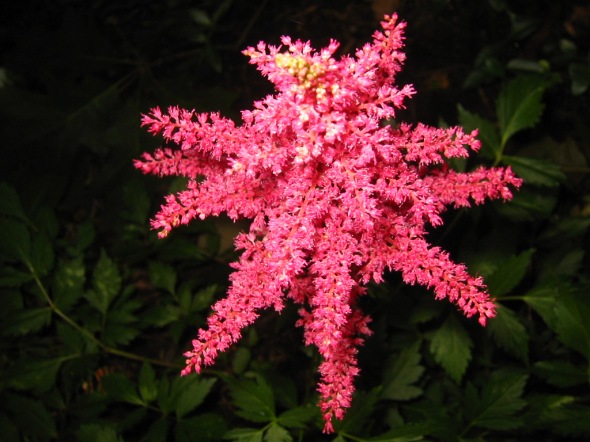Astilbe ~ False Spirea Plant Care Guide ~ Varieties
Astilbe /əˈstɪlbiː/[1] is a genus of 18 species of rhizomatous flowering plants, within the family Saxifragaceae, native to mountain ravines and woodland in Asia and North America.[2] Some species are commonly known as false goat’s beard, and false spirea.
These hardy herbaceous perennials are cultivated by gardeners for their large, handsome, often fern-like foliage, and dense, feathery plumes of flowers. They are widely adapted to shade and water-logged conditions, hence they are particularly associated with pond-side planting. They also tolerate clay soils well. Numerous hybrid cultivars have been raised. Flowers of at least some astilbe species have a strong and pleasant aroma.
Species of Astilbe include:
- Astilbe biternata (Vent.) Britt.
- Astilbe chinensis (Maxim.) Franch. & Sav.
- Astilbe crispa (Arends) Bergmans
- Astilbe grandis Stapf ex E. H. Wilson
- Astilbe japonica (C.Morren & Decne.) A.Gray
- Astilbe longicarpa (Hayata) Hayata
- Astilbe macroflora Hayata
- Astilbe microphylla Knoll
- Astilbe platyphylla H. Boiss.
- Astilbe rivularis Buch.-Ham. ex D. Don
- Astilbe rivularis var. angustifoliolata H. Hara
- Astilbe rivularis var. myriantha (Diels) J. T. Pan
- Astilbe rubra Hook. f. & Thomson
- Astilbe sikokumontana Koidz.
- Astilbe simplicifolia Makino
- Astilbe thunbergii (Siebold & Zucc.) Miq.
- Astilbe thunbergii var. congesta H. Boissieu
- Astilbe thunbergii var. fujisanensis (Nakai) Ohwi
- Astilbe thunbergii var. hachijoensis (Nakai) Ohwi
- Astilbe thunbergii var. kiusiana Hara
- Astilbe thunbergii var. longipedicellata Hatus.
- Astilbe thunbergii var. okuyamae (Hara) Ohwi
- Astilbe thunbergii var. shikokiana (Nakai) Ohwi
- Astilbe thunbergii var. terrestris (Nakai) Ohwi
Cultivar Groups
Commonly accepted cultivar groups are:
- Astilbe Arendsii Group
- Astilbe Crispa Group
- Astilbe Japonica Group
- Astilbe Simplicifolia Group
The following varieties and cultivars have gained the Royal Horticultural Society‘s Award of Garden Merit:-
******

Astilbe @ Old Farmer’s Almanac
Botanical name: Astilbe
Plant type: Flower
USDA Hardiness Zones: 3, 4, 5, 6, 7, 8, 9
Sun exposure: Full Sun, Part Sun
Soil type: Loamy
Flower color: Red, Pink, White
Astilbe is a perennial with beautiful, showy flowers atop glossy, fern–like foliage. Its flower clusters vary in size from 6 inches to 2 feet and its height varies from 6 inches to 5 feet, depending on the type. Astilbes are easy to care for and will live for a long time in your garden. Their only requirement is moisture.
Planting
- You can plant astilbe seeds, but they are short–lived and difficult to germinate. It is easier to plant the divisions from other astilbe plants.
- Plant the divisions in the spring or fall about 1 to 3 feet apart, depending on the type. If you are planting bare-root plants, make sure the holes are twice as wide as the plants and 4 to 6 inches deep. Place the plants so that the crown is 1 to 2 inches below the ground level. Cover the roots with soil and press firmly.
- Make sure to plant the divisions in consistently moist, humus-rich soil. Dry soil can be fatal to your plants. If you like in the North, you can plant them in full sun as long as they have moist soil. To prolong the foliage, provide shade from hot afternoon sun. In warmer regions, you must plant astilbes in light to partial shade. Astilbes can grow in deep shade but will not flower as much.
Care
- Remember to regularly check your astilbes to make sure they are moist. Water accordingly.
- Astilbes spread quickly and form broad clumps. Their crowns often rise above the soil as they grow, so make sure to cover them with humus-rich soil or lift and replant the clumps.
- Your astilbes will benefit from a balanced organic fertilizer applied in the spring.
- Be sure to divide the overgrown clumps every 3 to 4 years in the spring. You can either replant the divisions immediately or put them in pots to be planted out in the early summer when they are re-established.
- Removing the flower heads will not promote continued flowering.
Pests
- Tarnished plant bug
- Powdery mildew
- Bacterial leaf spots
Recommended Varieties
- Fanal, for its dark green foliage and dark crimson flowers
- Irrlicht, for its dark green foliage and elegant white flowers
- Venus, for its bright green foliage and bright pink flowers
Special Features
- Attracts Butterflies
****************

See Also ….
Native Plant Database
Astilbe @ National Gardening Assoc.
Astilbe Planting Guide @ Easy to Grow Bulbs







Pingback: Goat’s Bread (Aruncus dioicus) | Find Me A Cure